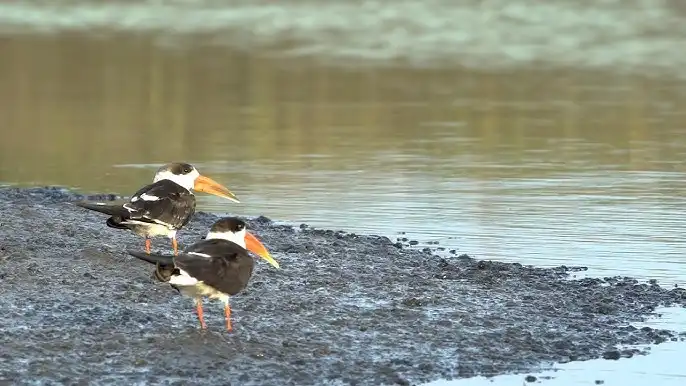The Indian Skimmer (Rynchops albicollis) is a fascinating bird native to South Asia. It stands out due to its unique feeding method. Easily recognised by its striking black-and-white plumage and bright orange beak, the Indian Skimmer is famous for its unusual method of skimming the water to catch fish, making it a rare and captivating sight along rivers and wetlands.

Physical Features
The Indian Skimmer has a striking appearance. Its upper body is black, while its underbelly is white. The most eye-catching feature is its beak, which is orange with a lower mandible that is much longer than the upper one. This special beak helps the bird skim across the surface of the water to catch small fish and aquatic creatures.

The bird’s wings are long and angular, designed for fast, precise flight. As it flies low over the water, it dips its long beak into the surface, scooping up fish as it moves. This feeding technique is not only efficient but also quite dramatic to witness.

Habitat and Distribution
The Indian Skimmer is typically found along large rivers, lakes, and wetlands. It favours regions with sandy islands or mudflats, where it forms colonies, often in the company of terns. The species is mainly found in countries like India, Pakistan, Bangladesh, and Myanmar. During the winter, it migrates to areas with calm, slow-moving waters, like those found in parts of southern India and Sri Lanka.

One of the key areas for spotting Indian Skimmers is the Chambal River, which runs through northern India. This river has become a significant sanctuary for the bird due to its clean waters and sandy banks. In recent years, large numbers of skimmers have also been spotted in Andhra Pradesh’s Bhairavapalem mudflats during their winter migration.

Feeding and Behaviour
The Indian Skimmer’s feeding method is its most unique trait. As its name suggests, the bird skims the water’s surface with its lower beak submerged. When the lower mandible touches a fish or prey, the beak snaps shut, capturing the meal. This feeding style requires calm water and abundant fish populations, which is why the bird prefers undisturbed rivers and lakes.

Apart from feeding, Indian Skimmers are highly social birds. They often nest in colonies, laying eggs in shallow scrapes on sandy islands or riverbanks. These colonies offer some protection from predators, but the birds’ eggs are still vulnerable to disturbances caused by humans and animals.

Conservation Status
Unfortunately, the Indian Skimmer is currently classified as Endangered due to several threats. Habitat loss is a major issue, as rivers and wetlands are being affected by dam construction, water pollution, and increased human activity. The destruction of sandbanks, where skimmers breed, has further reduced their chances of survival. Illegal sand mining along riverbanks also significantly affects the declining numbers of birds.

In recent years, conservation efforts have focused on protecting the habitats where Indian Skimmers are known to thrive. Several organisations and government bodies, such as the Wildlife Institute of India, are working to conserve the bird’s habitats, especially in key locations like the Chambal River. These efforts are vital in ensuring that the species does not slip further towards extinction.

The Importance of the Indian Skimmer
The Indian Skimmer is not just a beautiful bird to observe; it also plays an essential role in the ecosystem. As a predator of small fish, it helps to keep the population of aquatic species balanced, contributing to the health of the river ecosystems it inhabits. Moreover, the bird’s presence is an indicator of the overall health of freshwater bodies. When skimmers are found in large numbers, it suggests that the water quality and fish populations are thriving.
Efforts to protect the Indian Skimmer go beyond just saving a single species; they also involve preserving vital freshwater habitats, which are essential for numerous other animals, plants, and humans.

How You Can Help
While the Indian Skimmer faces many challenges, there are ways in which we can all contribute to its conservation. Supporting organisations dedicated to wildlife protection, spreading awareness about the bird’s plight, and advocating for the protection of rivers and wetlands can all make a difference. Additionally, promoting sustainable practices, such as responsible sand mining and pollution control, can help preserve the habitats where the Indian Skimmer lives.
Conclusion
The Indian Skimmer is a remarkable species that not only captivates birdwatchers with its striking appearance and unique behaviour but also serves as an important indicator of the health of its natural habitats. As an endangered species, it requires urgent conservation efforts to protect its breeding grounds and ensure its survival. Through collective efforts, we can help safeguard the future of this exceptional bird and the ecosystems it calls home.
For more interesting articles, please visit www.kidzherald.com





